Key Takeaways
- Denim originated as a durable workwear fabric in 17th-century France
- Levi Strauss and Jacob Davis revolutionized denim with riveted jeans in 1873
- Denim transitioned from workwear to fashion icon in the mid-20th century
- Various washes and finishes create unique denim looks and textures
- Sustainable denim production is gaining importance in the fashion industry
- Denim fits and styles cater to diverse body types and personal preferences
- Eco-friendly denim brands are leading initiatives for responsible production
- Denim’s versatility allows for styling options across multiple occasions
- The timeless appeal of denim ensures its enduring place in fashion
- Future denim trends focus on sustainability, technology, and customization
The humble “serge de Nîmes” has come a long way since its inception in 17th-century France. From rugged workwear to high fashion staple, denim has woven itself into the very fabric of our culture. This versatile material has stood the test of time, evolving with each passing decade while maintaining its core appeal.
As we unravel the rich tapestry of denim’s history and explore its current place in the fashion world, we’ll discover why this iconic fabric continues to captivate fashion enthusiasts and casual wearers alike. Join us on a journey through the blues and beyond, as we decode the enduring allure of denim.
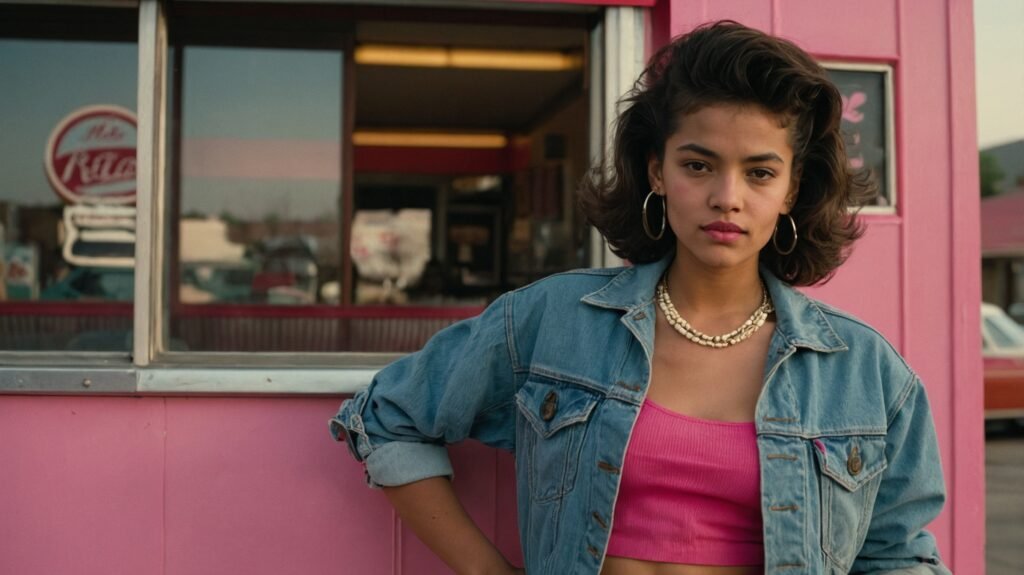
Origins
Denim’s origins trace back to 17th-century France. The “serge de Nîmes” fabric was durable, making it ideal for workwear. This practical material was later adopted by American laborers. In the 19th century, denim’s sturdy nature made it popular among miners and cowboys.
In 1873, Bavarian immigrant Levi Strauss and tailor Jacob Davis transformed the world of denim by inventing durable work pants. They secured a patent for reinforcing denim trousers with copper rivets, a key innovation that made these pants exceptionally sturdy. These rugged garments, now known as blue jeans, quickly gained popularity among workers and laborers for their strength and reliability.
Denim transcended its workwear roots in the mid-20th century. In the 1950s, influenced by film stars like James Dean and Marlon Brando, teenagers began wearing jeans as a symbol of rebellion. This shift marked denim’s entry into youth culture.
By the 1970s, fashion designers started experimenting with denim fabric, introducing a range of new denim styles and innovative washes. These creative changes helped elevate denim from casual wear to a high fashion staple. The punk and rock music scenes quickly embraced this denim trend, establishing it as an iconic element of pop culture and street style.
Throughout the 1980s and 1990s, denim’s versatility grew. It appeared on runways and in everyday wardrobes in diverse forms such as jackets, skirts, and shorts. This period solidified its place as a fashion staple.
Today, denim is synonymous with timeless style. It remains a versatile fabric that continues to evolve within the fashion industry, proving its enduring appeal from its humble beginnings to its current status as fashion iconography.
History of Denim fabric

Denim’s roots can be traced back to the 17th century. In the French town of Nîmes, weavers developed a durable cotton twill fabric. They called it “serge de Nîmes,” from where the word “denim” originates. This sturdy material was highly valued for its resilience and strength.
In the late 19th century, denim crossed the Atlantic. American laborers, including miners and cowboys, sought tough clothing for their grueling work. This need led Levi Strauss, a German immigrant, to collaborate with tailor Jacob Davis in 1873. They reinforced denim pants with copper rivets at stress points, creating what is now known as jeans.
Their invention rapidly gained popularity among workers across America. Denim’s robustness made it perfect for hard labor. Over the decades, the fabric found its place in various industries, solidifying its reputation as the go-to for durable workwear.
The mid-20th century marked a turning point. Hollywood actors like James Dean and Marlon Brando popularized jeans in the 1950s. They became symbols of youth rebellion and non-conformity. Teenagers adopted jeans as a wardrobe staple, sparking denim’s transition from workwear to everyday fashion.
By the 1970s, designers began to explore denim’s potential. Experimentation with styles and washes transformed it into a fashion icon. The punk and rock scenes embraced the fabric, embedding denim in pop culture.
Today, denim remains synonymous with durability and style. Its journey from “serge de Nîmes” to global fashion staple underscores its timeless appeal. Denim’s history is rich with innovation and cultural significance, making it an enduring favorite across generations.
Denim evolution in the fashion industry
Denim started as workwear. It was rugged and practical, and miners and laborers wore it for durability. However, denim’s role changed over time. In the 1950s, actors like James Dean made jeans fashionable. Hollywood played a significant part in elevating denim.
By the 1960s and 1970s, designers saw denim’s potential. They began experimenting with styles and cuts. Bell bottoms and high-waisted jeans emerged. Denim became a canvas for self-expression. Music subcultures adopted it, adding a cool factor.
The 1980s brought designer denim into the spotlight. Brands like Calvin Klein and Guess popularized jeans as high fashion. Acid washes and distressed looks became trendy. Jeans were not just for casual wear anymore.
In the 1990s, denim maintained its stronghold. The grunge movement embraced oversized and ripped jeans. Hip-hop culture introduced baggier fits. Each style symbolizes different cultural identities.
The 2000s saw advancements in fabric technology. Stretch denim provided comfort along with style. Skinny jeans dominated the market, appealing to younger generations. Denim became versatile and suitable for various occasions.
Today, denim continues to evolve. Sustainable and eco-friendly practices are gaining importance. New blends and innovative finishes keep denim fresh and relevant. It remains a staple in wardrobes worldwide.
In summary, denim’s evolution is remarkable. From tough workwear to style statement, it has adapted through decades. Its journey reflects changing societal trends and individualism. Denim’s ability to reinvent itself ensures its place in fashion’s future.
Types of Denim Washes and Finishes

Different Denim Washes and Their Effects
Denim washes impact the look and feel of jeans. A few common washes include raw, stone, acid, and vintage.
Raw denim is untreated. It has a deep, rich blue hue. Over time, it develops unique wear patterns.
Stonewash involves pumice stones. This process lightens the fabric and adds softness, creating a worn-in look.
Acid wash gives the denim a marbled appearance. Chemicals are used to achieve this effect, which results in high-contrast patterns.
Vintage wash mimics natural wear and fading. This process gives jeans a soft feel. It often results in lighter, distressed areas.
Each wash serves a different purpose. Consumers can choose based on personal style.
Popular Denim Finishes and Their Characteristics
Denim finishes enhance both appearance and functionality. Some popular finishes include distressing, whiskering, and enzyme wash.
Distressing involves creating intentional wear and tear. Techniques include ripping, sanding, and abrading. This finish adds character to the jeans.
Whiskering refers to creases near high-wear areas like the crotch and thighs. It gives jeans a worn-in look without prolonged wear.
Enzyme wash uses natural enzymes to soften denim. This eco-friendly method reduces the impact on the environment, resulting in a softer, more comfortable fabric.
Coated denim features a thin layer of resin or wax. This finish adds sheen and structure to the fabric. It’s suitable for fashion-forward styles.
Understanding these washes and finishes helps consumers make informed choices. They can find jeans that align with their preferences and needs.
Different denim washes and their effects
Denim washes affect both the look and feel of jeans. Different methods result in varied textures and colors. Raw denim is untreated, maintaining a deep blue shade. Over time, raw denim develops personalized wear patterns.
Stone wash uses pumice stones to fade the fabric. This creates a softer texture and a worn-in appearance. Jeans treated this way lose some of their deep blue color but gain comfort and character.
Acid wash involves treating denim with chemicals. The process produces a marbled effect, giving jeans high-contrast, dramatic patterns. These jeans stand out for their unique designs.
Vintage wash aims to mimic natural aging. This method results in faded areas and a softer hand feel. Vintage-washed jeans often appear lighter and more distressed, capturing a timeless look.
Bleach wash significantly lightens denim. By applying bleach, manufacturers achieve the lightest shades of blue and white. This wash often leads to a striking contrast between the bleached sections and the original fabric.
Each type of wash offers distinct visual and tactile qualities. Consumers can select based on personal preferences and style needs. Understanding these different washes helps in choosing the right pair of jeans. Each wash enhances the fabric in a specific way, balancing aesthetics with comfort.
Ultimately, the variety of denim washes caters to a broad range of tastes, ensuring a perfect fit for every denim enthusiast.
Popular denim finishes and their characteristics
Denim finishes add unique properties to jeans, enhancing their look and feel. One popular finish is selvage denim. It offers a clean, tightly woven edge and is highly durable. The fabric has a premium feel and develops distinctive fades over time.
Distressed finishes create a worn-in effect. This involves sanding, ripping, or fraying areas of the jeans. Consumers often prefer this look for its rugged and casual appearance.
Coated finishes provide a shiny or matte surface. A layer of wax or resin is applied to the denim. This makes the fabric more water-resistant and gives it a modern, edgy look.
Stretch denim includes elastic fibers like spandex. This adds flexibility, enhancing comfort and fit. Stretch jeans are ideal for active lifestyles or those who value comfort.
Rinsed/washed denims are soaked to remove excess dye. This process makes the fabric softer and reduces shrinkage. It results in minimal color loss but improves overall comfort.
Overdyed denim involves dyeing the fabric multiple times. This creates rich, dark colors that don’t fade easily, offering a sophisticated, uniform appearance.
Lastly, vintage finishes mimic the natural aging process of denim. Techniques like enzyme washes and hand-sanding are used. The result is soft, comfortable jeans with nostalgic appeal.
These diverse finishes cater to different tastes and needs. They enhance the versatility and appeal of denim, making it a beloved fabric in various wardrobes.
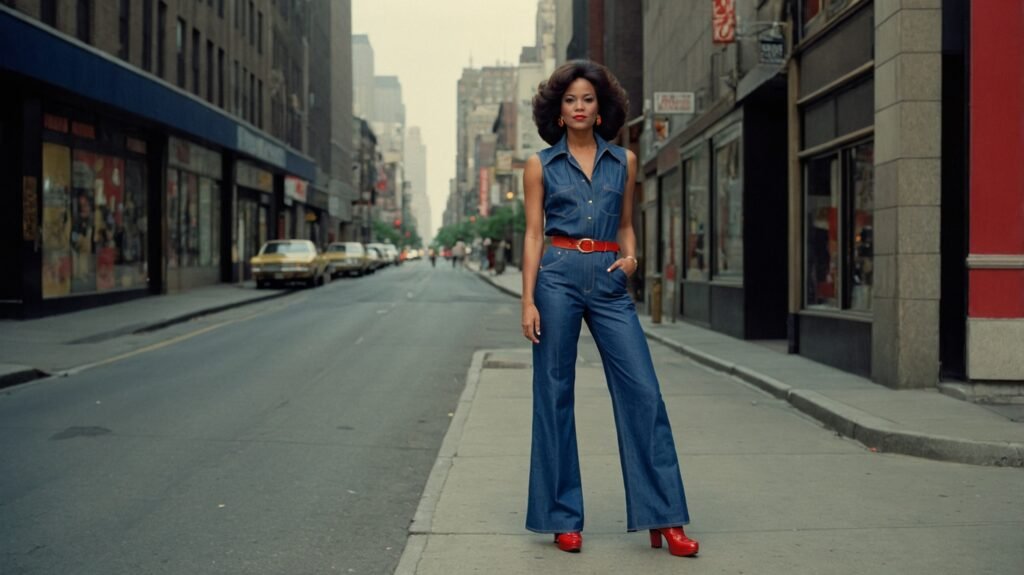
Denim Fit Guide: Finding the Perfect Pair
Understanding denim fits and styles.
When it comes to denim fits, there are multiple options. Straight-leg jeans offer a classic silhouette. They fit snugly at the waist and fall straight down. Skinny jeans are a popular choice. These jeans hug the body tightly from the waist to the ankle.
Bootcut jeans flare out slightly at the bottom. This style pairs well with boots, as the name suggests. Boyfriend jeans offer a relaxed, baggy fit. They provide maximum comfort and a casual look.
High-waisted jeans sit above the natural waistline, elongating the legs and accentuate the waist. On the other hand, low-rise jeans sit below the hips. These are often preferred in casual or stylish settings.
Tips for finding the right denim fit
Selecting the right pair of jeans involves several steps. First, determine your size accurately. Measure your waist and hips for a precise fit.
Next, consider your body type. Slimmer frames might opt for straight or skinny jeans. For curvier figures, high-waisted or bootcut styles work well.
Always try on multiple pairs. Different brands have varied sizing standards. Walking and sitting in the jeans help gauge comfort and flexibility.
Functionality is crucial. Think about when and where you’ll wear them. Stretch denim benefits active lifestyles. Darker washes are suitable for formal settings.
Lastly, trust your instincts. If a pair feels right and looks good, it’s likely a great choice. Each pair tells its own story, making it an essential wardrobe staple.
Understanding denim fits and styles

When exploring denim fits, there are various styles to consider. Straight-leg jeans offer a timeless silhouette. They fit snugly at the waist and fall straight down to the ankle. Skinny jeans, on the other hand, hug the body tightly from waist to ankle, offering a sleek and modern look.
Bootcut jeans are another popular option. These flare out slightly at the bottom, making them ideal for pairing with boots. For those who favor a more relaxed fit, boyfriend jeans are the way to go. This style offers a baggy fit, maximizing comfort and a casual appearance.
High-waisted jeans have surged in popularity. They sit above the natural waistline, which helps elongate the legs and accentuate the waist. Conversely, low-rise jeans sit below the hips and are often chosen for casual and trendy outfits.
Each style provides unique benefits depending on body type. Slimmer figures might gravitate toward straight or skinny jeans for a flattering fit, while curvier individuals may prefer high-waisted or bootcut styles to balance their proportions.
It’s essential to try on multiple pairs when shopping. Different brands have varied sizing standards, so walk and sit in the jeans to test for comfort and flexibility.
Ultimately, selecting the right denim fit involves considering both style and functionality. Whether aiming for a chic or relaxed look, there’s a pair of jeans to match every preference and occasion.
Tips for finding the right denim fit
Finding the perfect pair of denim can feel challenging. However, there are several strategies to help streamline the process.
First, consider body type. Different fits complement different shapes. For example, straight or skinny jeans typically suit slimmer figures, while high-waisted or bootcut jeans can balance curvier proportions.
Next, pay attention to sizing. Sizes vary across brands, so try multiple pairs. Don’t hesitate to go up or down a size. The goal is a comfortable and flattering fit, not strictly to a number.
Fabric stretch also matters. Opt for jeans with a bit of elastane or spandex for added comfort and flexibility. These materials allow the denim to move with the body, making them more practical for everyday wear.
It’s crucial to test mobility. Walk around the store, sit down, or bend your knees while trying on jeans. Ensuring ease of movement can help determine if the fit is right.
Consider the rise of the jeans. High-rise options elongate the legs, while mid-rise balances high and low styles. Low-rise jeans are best for casual, trendy looks but may not suit everyone.
Color and wash play roles in fit perception too. Dark washes tend to be slimming and versatile, appropriate for both casual and formal settings. Lighter washes offer a relaxed, casual vibe but may highlight certain areas.
Finally, trust personal comfort over trends. What feels good often looks good too. Remember these tips to find denim that matches style and comfort needs effectively.

Sustainable Denim Practices: Eco-friendly Choices
Importance of sustainable denim production
Sustainable denim production is crucial. It reduces environmental impact. Traditional denim uses a lot of water and chemicals. These practices harm ecosystems. Eco-friendly production aims to minimize these effects.
Energy-efficient machinery is essential. Brands now use advanced technology to lower energy consumption. This shift saves resources and cuts down on greenhouse gas emissions.
Dyes and finishes play significant roles. Natural dyes replace harmful chemicals. Waterless dye technology is growing in popularity. This technology conserves water, making it a more sustainable option.
Fabric choices make a difference. Organic cotton is a great alternative. It is grown without pesticides and synthetic fertilizers. Recycled denim also gains traction. It reuses old material, reducing waste.
Eco-friendly denim brands and initiatives
Several brands lead the sustainable denim movement. Levi’s Water
Another key player is Nudie Jeans. This brand emphasizes transparency and sustainability. They use organic cotton and offer free repairs. Their recycling program encourages customers to return worn jeans for reuse.
Patagonia is also a pioneer. Known for its environmental focus, Patagonia utilizes recycled materials in their denim line. Their Fair Trade Certified™ initiatives ensure ethical labor practices.
Innovative startups contribute as well. Everlane prioritizes “Radical Transparency.” They disclose factory conditions and production costs openly. Similarly, Outerknown uses organic and recycled fibers, reducing environmental footprints.
Collective effort in sustainable denim continues to grow. Consumers are becoming more eco-conscious. Supporting these brands helps promote a greener future for fashion.
Importance of sustainable denim production
Sustainable denim production is vital. Traditional denim requires excessive water and chemicals. This process damages ecosystems significantly. Eco-friendly denim practices aim to reduce these impacts considerably.
Energy consumption in denim production is high. Adopting energy-efficient machinery lowers usage. It also cuts greenhouse gas emissions. Brands are increasingly investing in such technologies.
Dyeing traditional denim involves harmful chemicals. Natural dyes offer a safer alternative. Advances in waterless dye technology also conserve water. These methods are becoming popular for their sustainability.
Fabric choice is crucial in eco-friendly denim. Organic cotton is a better option than conventional cotton. It’s grown without pesticides and synthetic fertilizers. Recycled denim reuses old materials, reducing waste.
Water is a precious resource in denim production. Initiatives like Levi’s Water
Brands like Nudie Jeans emphasize transparency and sustainability. They use organic cotton and encourage recycling through free repairs. Patagonia integrates recycled materials into their denim line, promoting an eco-friendly approach.
Ethical labor practices are essential. Fair Trade Certified™ initiatives ensure workers are treated fairly. This focus supports both the environment and communities involved in production.
The demand for sustainable practices is growing. Consumers are more eco-conscious than ever. Supporting sustainable denim brands can drive positive change. Sustainable denim not only protects the planet but also promotes responsible fashion consumption.
Eco-friendly denim brands and initiatives
Brands are increasingly focusing on sustainable denim. Levi’s leads the way with initiatives like their Water
Nudie Jeans emphasizes transparency and ethical practices. They exclusively use organic cotton, avoiding harmful pesticides. Nudie Jeans also promotes circular fashion by offering free repair services to extend the lifespan of their products.
Patagonia is another pioneer in eco-friendly denim. Their denim line incorporates recycled materials, minimizing waste. Additionally, Patagonia ensures their products are Fair Trade Certified™, supporting fair labor practices.
Everlane champions radical transparency. They disclose their production costs and processes. Everlane’s denim collection focuses on sustainability by using less water and chemicals.
MUD Jeans operates on a circular economy model. Customers can lease jeans and return them for recycling. This approach effectively reduces waste while promoting material reuse.
G-Star RAW has made significant strides in eco-friendly denim. They utilize sustainable materials like organic cotton and recycled polyester. Their collaboration with Pharrell Williams focuses on innovation, with pieces made from recycled ocean plastic.
AG Jeans boasts of their environmentally responsible production processes. By adopting ozone technology, they reduce water and chemical usage in their washes.
DL1961 is celebrated for its eco-conscious approach. They use sustainable fibers like Tencel and recycled cotton. Their efficient production methods further reduce environmental impact.
These brands are at the forefront of sustainable denim. Their initiatives highlight the possibilities within the fashion industry to support environmental conservation while maintaining style and quality.
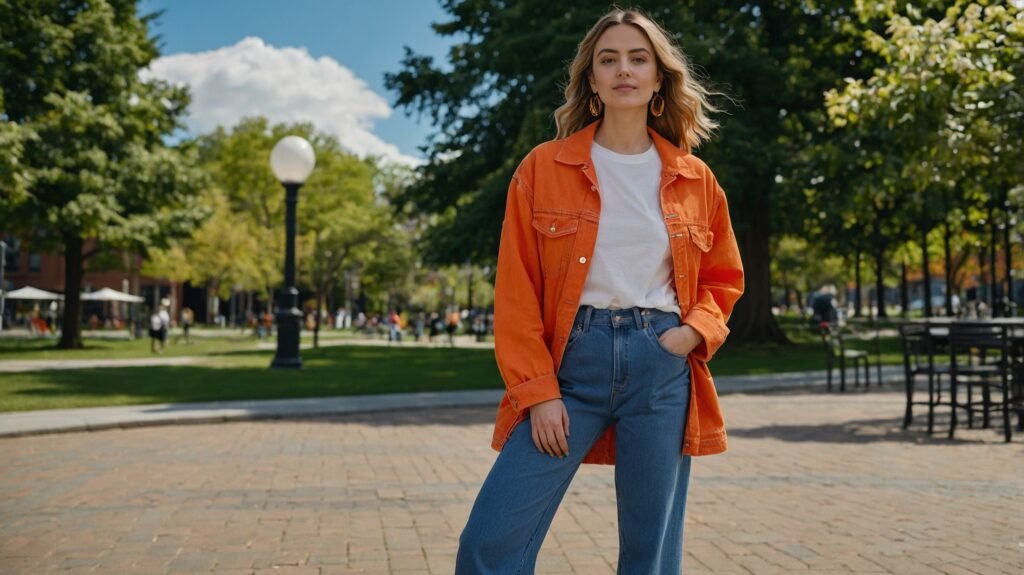
Styling Denim: Versatile Fashion Options
Denim is incredibly versatile, making it a staple in wardrobes across the globe. For casual occasions, nothing beats a pair of classic blue jeans paired with a simple white T-shirt. This timeless look is both effortless and stylish.
Denim jackets offer another level of versatility. They can be thrown over a summer dress for a laid-back vibe or layered with sweaters in colder months. Denim skirts, ranging from mini to maxi lengths, provide countless outfit options. They can be dressed up with heels and a blouse or kept casual with sneakers and a tank top.
Colored denim adds flair to the usual blue hues. Pairing vibrant denim pants with neutral tops creates balanced, eye-catching outfits. Denim overalls are another playful option, perfect for both youth and adults. They can be worn solo or layered over T-shirts and sweaters for added dimension.
For workwear, dark-wash jeans offer a more polished appearance. Paired with blazers and button-down shirts, they strike a balance between professional and comfortable. High-waisted jeans elongate the legs and can be paired with cropped tops or tucked-in blouses for a chic look.
Double denim, when done right, is striking. Choose different tones for the top and bottom to avoid monotony. Light-washed jackets with dark-washed jeans create a dynamic duo.
In essence, denim is adaptable to various styles and occasions, proving its timeless quality in the fashion arsenal.
Denim styling for different occasions
Denim can be styled for a variety of occasions, making it a versatile addition to any wardrobe. For casual outings, pairing a classic pair of blue jeans with a simple white T-shirt creates an effortless look. Add sneakers for comfort and style.
For semi-casual events, a denim skirt combined with a flowy blouse strikes the perfect balance. A pair of ankle boots can elevate the entire outfit, offering both sophistication and ease.
Work environments can also benefit from denim’s versatility. Dark-wash jeans paired with a crisp button-down shirt and a blazer create a professional yet comfortable ensemble. Opting for high-waisted jeans can provide a polished appearance while elongating the legs.
Evening gatherings allow for more adventurous denim choices. A fitted denim jumpsuit worn with high heels and statement jewelry ensures a chic, standout look. Alternatively, a denim jacket thrown over a sleek dress can add an edge to an otherwise elegant outfit.
In terms of summer style, denim shorts are a go-to option. Pair them with tank tops and flip-flops for a relaxed vibe. During colder months, layering becomes key. Denim jackets over sweaters or hoodies provide warmth without sacrificing style.
For those who enjoy mixing textures, denim overalls offer playful outfit possibilities. Layer them over simple tees or turtlenecks depending on the season. This blend of comfort and style is perfect for both day-long adventures and laid-back evenings.
Denim’s adaptability makes it easy to mix and match with other clothing pieces. Thus, it seamlessly transitions from casual to sophisticated, casual Fridays to weekend brunches.
Mixing and matching denim with other clothing pieces
Denim’s versatility makes it a staple in any wardrobe. Pairing denim with different clothing pieces is both stylish and practical. For a casual look, blue jeans work seamlessly with graphic tees. Add sneakers to complete the outfit. Denim jackets pair well with floral dresses, creating a chic, layered look perfect for spring.
In a workplace setting, dark-wash jeans can be dressed up. Combine them with a crisp white shirt and loafers for a business-casual vibe. A slim-fit denim shirt looks sharp tucked into tailored trousers. This combination offers a modern twist on traditional workwear.
Denim skirts are another flexible option. They match effortlessly with cozy sweaters in cooler months. During summer, a simple tank top pairs well for a relaxed, casual look. Transitioning from day to night? Opt for heeled sandals and statement jewelry.
Layering is another effective technique. A denim jacket over a hoodie provides warmth and style. For a more polished appearance, layer a denim shirt under a blazer. This ensemble is great for casual Fridays at the office.
Don’t forget about accessories. Denim can be paired with almost any accessory to enhance the outfit’s overall look. Consider adding scarves, hats, or belts for a personalized touch.
For those who enjoy eclectic styles, mixing different shades of denim can be fun. Denim-on-denim outfits are trendy when executed thoughtfully. Balance is key: if the top is light-wash, choose dark-wash jeans or vice versa.
In essence, denim’s adaptability ensures countless fashion possibilities. Whether casual or formal, denim pieces can be mixed and matched effortlessly. Denim continues to provide timeless appeal that fits every occasion.
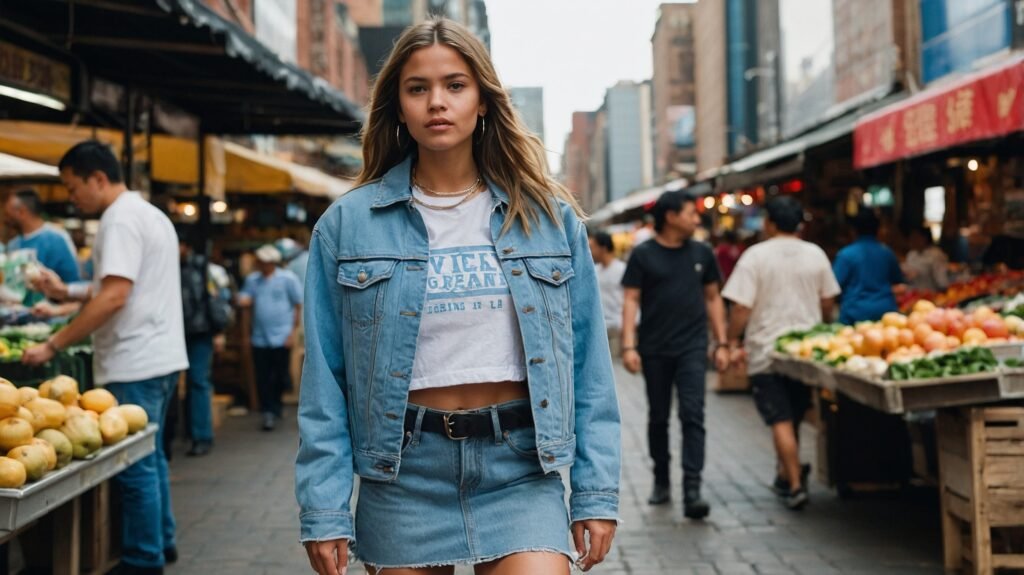
Conclusion
Denim’s journey from workwear to fashion staple highlights its enduring charm. This fabric, known for its durability and versatility, has adapted through the years. It remains a favorite, transcending age and fashion trends.
From raw indigo to distressed finishes, denim offers endless possibilities. Washes, fits, and styles continue to evolve, meeting the needs of fashion enthusiasts everywhere. Denim’s unmistakable appeal lies in its ability to fit various occasions. Whether casual or formal, denim pieces cater to all events effortlessly.
Sustainable practices in denim production are gaining traction. More brands are embracing eco-friendly methods, promoting a healthier planet. Innovations in recycling and reducing water usage are leading the way. This shift represents a positive trend in the fashion industry.
Modern styling options elevate denim’s status further. Mixing different pieces creates unique looks, showcasing individual style. From jeans to jackets and skirts, denim remains a wardrobe essential. Accessories and layers add depth, making denim outfits distinctive.
The future of denim seems bright. Upcoming trends indicate a focus on comfort and sustainability. There is a growing preference for relaxed fits and organic materials. The introduction of innovative designs continues, keeping denim relevant.
In sum, denim’s timelessness ensures it will retain its place in the realm of fashion. Its ability to adapt while maintaining core characteristics cements its legacy. Denim not only tells a story of history but also continues to write new chapters in fashion’s book.
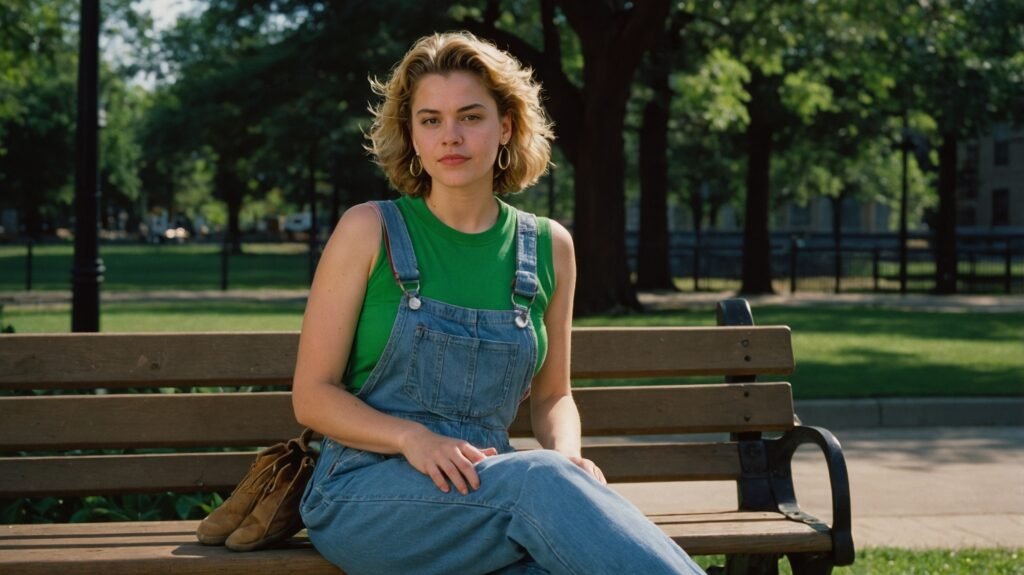
The timeless appeal of denim
Denim possesses a universal appeal that transcends generations. Its durability makes it a practical choice. People of all ages and backgrounds embrace it. Denim’s ability to adapt to various styles is notable. It can be casual or elegant, depending on the occasion.
The fabric’s natural comfort is unmatched. When worn, denim molds to the body’s shape, enhancing wearability. This breathability ensures it remains a favorite in wardrobes worldwide. Season after season, denim maintains its relevance.
Fashion trends come and go, but denim stays constant. Its versatility is key. From jeans to jackets, dresses, and skirts, denim fits well in any ensemble. The timeless piece can be dressed up or down, making it suitable for both street style and formal events.
Moreover, denim has a rich history. Originally designed as workwear, it has evolved into a fashion statement. Icons in music and film have popularized it, adding to its allure. Even today, celebrities flaunt denim in unique ways, keeping the fabric in the spotlight.
Additionally, the diverse range of washes and finishes allows endless customization. Consumers enjoy personalizing their denim pieces, expressing individuality through different styles and textures.
Looking ahead, denim’s future appears bright. Innovations in sustainable practices are gaining momentum. Eco-friendly production methods appeal to the environmentally conscious consumer. Brands are now focusing on reducing water usage and recycling materials.
In conclusion, denim’s enduring charm lies in its effortless blend of practicality and style. This fabric continues to evolve, reflecting both tradition and modernity, making it an enduring staple in fashion globally.
Future trends in denim fashions

Designers are continually reinventing denim. One emerging trend is the focus on sustainability. Eco-friendly practices are becoming more prominent. Brands use less water and use recycled materials. Organic cotton is gaining popularity.
Another trend is the revival of vintage styles. High-waisted jeans and flared bottoms are making a comeback. Retro is the new modern. This nostalgia-driven fashion appeals to many consumers.
Additionally, customization is trending. People want unique denim pieces. Embroidery, patches, and personal touches are in demand. This allows for a more personalized wardrobe.
Technology also plays a role. Smart denim with integrated tech features is on the rise. Innovations include built-in chargers and health monitoring. Consumers are drawn to this blend of fashion and functionality.
Comfort remains a key focus. Stretch denim and softer fabrics are becoming standard. These materials ensure ease of movement and a snug fit. Athleisure influences can be seen here.
The color variety is expanding as well. Beyond traditional blues, greens, reds, and pastels are gaining traction. These options allow for more creative styling.
Brands are also experimenting with new silhouettes. Asymmetrical cuts and oversized fits offer fresh looks, catering to diverse tastes.
Lastly, collaborations between denim brands and artists are increasing. Limited edition pieces attract attention and create buzz.
Denim’s evolution continues to mirror changing consumer preferences. As trends shift, denim remains a versatile, enduring fabric in the fashion industry.

Frequently Asked Questions
What’s the best way to care for denim jeans?
Wash your jeans sparingly in cold water, turn them inside out, and air dry to maintain their shape and color. Avoid using the dryer as it can cause shrinkage and fading.
How often should I wash my jeans?
Generally, washing your jeans every 4-6 wears is sufficient. However, this can vary based on activity level and personal preference. Spot cleaning can help extend time between washes.
What’s the difference between selvage and regular denim?
Selvage denim is made on old-style shuttle looms, resulting in a self-sealed edge. It’s typically higher quality and more durable than regular denim, which is made on modern projectile looms.
Are raw denim jeans worth the investment?
Raw denim jeans can be worth it for enthusiasts who appreciate developing personalized wear patterns. They’re durable and often higher quality, but require more care and a breaking-in period.
How can I make my jeans last longer?
Wash less frequently, avoid harsh detergents, and repair small tears promptly. Rotate between multiple pairs to give each time to “rest” between wears.
What’s the most versatile denim wash?
A medium-dark blue wash is generally considered the most versatile. It can be dressed up or down and pairs well with most colors and styles.
How can I find jeans that fit well?
Try various styles and sizes, as fit can vary between brands. Consider your body type and preferred rise. Don’t hesitate to have jeans tailored for a perfect fit.
Are sustainable denim options really better for the environment?
Yes, sustainable denim options typically use less water, fewer harmful chemicals, and more eco-friendly production methods. While they may cost more, they often offer better quality and reduced environmental impact.

Anna West, the visionary behind Clothes Color Guide, is our go-to for all things fashion. Merging the finest of runway trends with everyday style, she demystifies the world of color and pattern. While clothing is her mainstay, Anna also shares insights on interior design, pet care, and relationship advice. Dive into her articles and emerge with a vibrant perspective on style and life.
Reviewed By: Joanna Perez and Marcella Raskin
Edited By: Lenny Terra
Fact Checked By: Sam Goldman
Photos Taken or Curated By: Matthew Mansour
